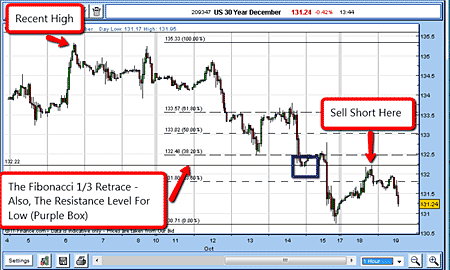How to calculate the 'missing' Fibonacci level - and profit from it
John C Burford explains how to use Fibonacci retracement via an example trade from the US Treasury bond market.
As you may know, I rely heavily on my trusty Fibonacci retracement tool on my spread-betting platform. In most cases, the percentage retracements built into the tool give pretty accurate turning points for rallies in a bear market, and dips in a bull market.
Fibonacci retracement analysis can work in any time-frame from weekly to minute-by-minute charts. This is down to the fractal nature of markets. I have covered this principle in the glossary. But it comes down to the fact that the interplay of traders' emotions over very short time-frames is identical to that over longer time-spans.
Let's consider this for a moment. Markets are driven by the emotions of traders, not the 'fundamentals'. Many investors and traders believe otherwise, but I maintain that since it is a human that pushes the 'buy' or 'sell' button, or has programmed the trading software, how that person feels about the market determines their actions.
MoneyWeek
Subscribe to MoneyWeek today and get your first six magazine issues absolutely FREE

Sign up to Money Morning
Don't miss the latest investment and personal finances news, market analysis, plus money-saving tips with our free twice-daily newsletter
Don't miss the latest investment and personal finances news, market analysis, plus money-saving tips with our free twice-daily newsletter
To demonstrate this, you can show the same set of 'fundamentals' to a number of traders, and you will get some that will be bullish and some that will be bearish. This is what creates the impression of non-rationality and what creates the market, which is simply an exchange where buyers and sellers come together. What rationality there is (and Elliott proves there is great order within the chaos), is contained in the price charts.
And this is apparent on any time-frame.
The 'missing' Fibonacci level and how to use it
On my trading platform, I have the standard Fibonacci levels of 23.6%, 61.8%, and 50%. But there is one important level that is missing. It is the 1/3 level (33.3%). Here is a great example of the use of the 1/3 retracement targeting in the T-bonds market recently:

T-bonds are US Treasury bonds with a life of 30 years. It was one of the earliest financial futures markets ever created. Today, trading volumes are immense half a trillion dollars' worth are often traded every day.
The T-bond is the benchmark for long-term US interest rates, and is of special interest to pension funds and insurance companies, who are large buyers (and sometimes sellers). The market is extremely liquid, and manipulation by special interests is effectively impossible (except, perhaps, by the Fed).
The market had rallied off a low in early September to a high in early October (marked on the chart as 'recent high') at the 135 area. It then fell back (despite the knowledge that the Fed would buy more Treasuries in a new round of quantitative easing). The market made a low on 15 October, and then rallied.
I was looking for a Fibonacci retrace of the fall from the 12 October high and applied my Fibonacci tool to the hourly chart. Since the market was in a downtrend, I was looking to short the market for a quick turn. On 18 October, the market unexpectedly zoomed past the first level at the 23.6% level at 131.80.
Should I wait for the market to hit the next level at 38.2% at 133? Because I was not expecting a very sharp bounce off the 15 October low, I decided to work out a 1/3 (33%) retracement and draw it in to the chart.
This is the solid line drawn at 132.22 (as you can see in the chart, reprinted below).

Interestingly, that is also the level of the resistance line underneath the low highlighted by the purple box. So now I have two possible co-incident turning points.
I decided to enter a resting sell order at the 132.20 level, which was filled late on the 18th.
For my stop, I placed it just above the 38.2% retrace level, just in case the market did make it up that high. For my stake, since my stop was only 55 pips away, I could bet £2 a pip and stay within my 3% rule.
18 Oct sell £2 Dec T-bonds @ 132.20
Stop @ 132.75
Risk £110 (2.2%)
The market did turn around there and the next day fell to 131.25 my target.
My resting buy order was filled.
19 Oct buy £2 Dec T-bonds @ 131.25
Profit £190. Risk £110
The reason I took a day-trade profit was simply that I judged that after some big moves earlier in the summer, the market would be range-bound for a while. It was no time to be taking a longer view.
Get the latest financial news, insights and expert analysis from our award-winning MoneyWeek team, to help you understand what really matters when it comes to your finances.
John is is a British-born lapsed PhD physicist, who previously worked for Nasa on the Mars exploration team. He is a former commodity trading advisor with the US Commodities Futures Trading Commission, and worked in a boutique futures house in California in the 1980s.
He was a partner in one of the first futures newsletter advisory services, based in Washington DC, specialising in pork bellies and currencies. John is primarily a chart-reading trader, having cut his trading teeth in the days before PCs.
As well as his work in the financial world, he has launched, run and sold several 'real' businesses producing 'real' products.

